Table of Contents
Union territories of India are areas directly controlled and administered by the Central Government of India, also known as “centrally administered territories.” The Andaman and Nicobar Islands were India’s first union territory after independence. On 31 October 2019, Ladakh was carved out of Jammu and Kashmir, and it was considered a separate UT, while Jammu and Kashmir was also converted into a union territory. Dadra, Nagar Haveli, and Daman & Diu merged on 26th January 2020. Therefore, India has 8 union territories currently, which were previously 9 union territories.
Union Territories of India
According to Article 1 of the Constitution, India’s territory includes:
- The states
- The union territories
- Any other territories that may be acquired.
Part VIII of the Indian Constitution (Articles 239-241) specifically addresses the Union Territories of India.
8 Union Territories of India
India is a union of states that operates under a democratic, socialist, secular, and republican style of government. Union territories are unique administrative divisions directly governed by the Central Government.
- Delhi (1956): Established as the National Capital Territory for administrative purposes.
- Andaman and Nicobar (1956): Chosen for its strategic importance in the Bay of Bengal.
- Chandigarh (1966): Created as a common capital for Punjab and Haryana for administrative needs.
- Dadra and Nagar Haveli and Daman and Diu (2020): Noted for its unique culture, having been a Portuguese territory.
- Jammu and Kashmir (2019): Set up for administrative, development, and security reasons.
- Ladakh (2019): Created to focus on tribal communities and their remote location.
- Lakshadweep (1956): Recognised for its strategic importance in the Arabian Sea.
- Puducherry (1956): Known for its unique culture as a former French territory.
What are Union Territories of India?
Union Territories of India are regions that fall directly under the administration of the Central Government. Unlike states, which have their governments, Union Territories (UTs) are governed by administrators or Lieutenant Governors (LGs), appointed by the President of India on the recommendation of the Prime Minister.
Key Features of Union Territories of India
- Central Control: UTs are directly governed by the Central Government, although some, like Delhi and Puducherry, have elected legislative assemblies.
- Lieutenant Governor: The LG is the chief administrator and representative of the President in the Union Territory.
- Legislative Powers: Only Delhi and Puducherry have legislative assemblies with limited law-making powers. The other UTs are directly administered by their LGs or administrators.
- Financial Management: The Central Government controls financial matters and provides grants and financial aid to UTs.
- Judiciary: The High Courts of nearby states generally have jurisdiction over UTs.
Evolution of Indian Union Territories
- Initially, Indian states were classified into four groups, with Part C states (former princely states) and Part D (Andaman and Nicobar Islands) forming the basis of UTs.
- 1956: The States Reorganisation Act officially introduced the concept of Union Territories by merging Part C and D states. The initial UTs were Andaman and Nicobar Islands, Lakshadweep, Delhi, Manipur, Tripura, and Himachal Pradesh.
- Over time, Manipur, Tripura, and Himachal Pradesh became full-fledged states.
- 1961: Dadra and Nagar Haveli became a UT, and
- 1962: Puducherry joined after its integration from French control.
- 2019: Jammu and Kashmir was bifurcated into two UTs—Jammu & Kashmir and Ladakh.
- 2020: Dadra and Nagar Haveli merged with Daman and Diu to form a single UT.
Governance of Union Territories of India
- President’s Role: The President of India has the authority to govern UTs, through administrators or LGs.
- Administrators and LGs: They oversee day-to-day administration and implement policies in line with the Central Government’s directives.
- Legislative Assemblies:
- Delhi and Puducherry have legislative assemblies, but their legislative powers are restricted compared to those of states.
- Delhi’s assembly, for instance, cannot legislate on public order, police, or land matters.
- No Assemblies: UTs without legislative assemblies, like Lakshadweep and Andaman & Nicobar Islands, are governed by their administrators.
Union Territories provide unique governance models, maintaining closer ties to the Central Government while catering to specific regional needs.
How many Union Territories are there in India?
India has 8 Union Territories which are Delhi, Andaman and Nicobar, Chandigarh, Dadra and Nagar Haveli and Daman and Diu, Jammu and Kashmir, Ladakh, Lakshadweep, and Puducherry are the eight union territories of India. We have provided the details about the Union territories of India along with their Capitals, Year of Foundation, Population and Area:
| Union Territories of India | Year of Foundation | Capital City | Population according to the 2011 census number | Area (km2) |
| Andaman and Nicobar Islands | November 1956 | Port Blair | 3,80,581 | 8,249 |
| Chandigarh | 1 November 1966 | Chandigarh | 10,55,450 | 114 |
| Dadra and Nagar Haveli and Daman and Diu | 26 January 2020 | Daman | 3,43,709 | 603 |
| Delhi | 1956 | New Delhi | 1,67,87,941 | 1,483 |
| Lakshadweep | 1 November 1956 | Kavaratti | 64,473 | 32 |
| Puducherry | 1 November 1954 | Pondicherry | 12,47,953 | 479 |
| Jammu and Kashmir | 31 October 2019 | Srinagar in Summer and Jammu in Winter | 1,22,67,013 | 42,241 |
| Ladakh | 31 October 2019 | Leh | 2,74,289 | 59,146 |
Capital of Union Territories of India
With a total land area of 59146 km2, Ladakh is the largest union territory in terms of size. The largest union territory is Delhi in terms of population. The 2011 Census determined that Delhi has a total population of 16,787,941 people.
| Union Territory | Capital |
| Jammu and Kashmir | Srinagar (Summer), Jammu (Winter) |
| Lakshadweep | Kavaratti |
| Chandigarh | Chandigarh |
| Dadra and Nagar Haveli and Daman and Diu | Daman |
| Puducherry | Puducherry |
| Andaman and Nicobar Islands | Port Blair |
| Delhi | New Delhi |
| Ladakh | Leh (summer), Kargil (winter) |
Ladakh, Chandigarh, Delhi, Dadra and Nagar Haveli, Daman and Diu, Jammu and Kashmir, Andaman and Nicobar, Lakshadweep, and Puducherry are the eight union territories in India.
| Note |
|
1. Andaman and Nicobar Islands
| Particulars | Description |
| Area | 8,249 sq. km |
| Population | 4 lakh (approx) |
| Capital | Port Blair |
| Languages | Hindi, Bengali, , Malayalam, Nicobarese, Tamil, Telugu |
- The union territory of the Andaman and Nicobar Islands has 38 inhabited islands.
- The union territory of the Andaman and Nicobar Islands is separated from Thailand and Myanmar by the Andaman Sea.
- An uncontacted tribe named the Sentinelese people is located in the Islands.
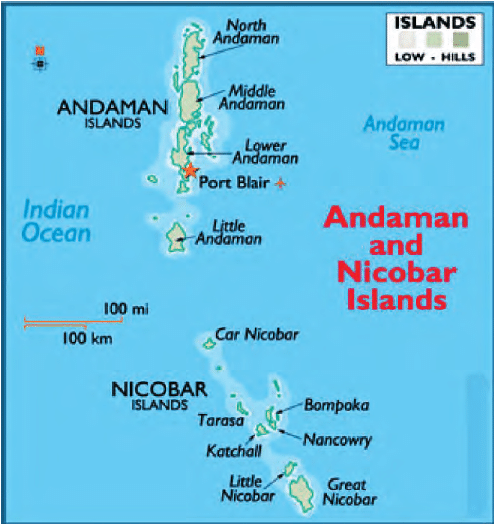
2. Dadra and Nagar Haveli & Daman and Diu
| Particulars | Description |
| Area | 603 sq km |
| Population | 4 Lakhs (Approx) |
| Capital | Daman |
| Languages | Gujarati, Marathi, Portuguese, Hindi, Varli, and Konkani |
- The two union territories of “Dadra and Nagar Haveli” and “Daman and Diu” were merged, and a single union territory was established on 26th January 2020.
- All these territories were former colonies of the Portuguese.
- Some of the major tourist attractions in Dadra and Nagar Haveli and Daman and Diu are Naida Caves, Diu Fort, Vanganga Lake Garden, BAPS Swaminarayan Temple, Tapovan Tourist Complex, Nakshatra Garden, Vasona Lion Safari, Satmalia Deer Sanctuary and Tribal Museum in Silvassa.

3. Lakshadweep
| Particulars | Description |
| Area | 32 sq. km |
| Population | 64,429 ( Approx ) |
| Capital | Kavaratti |
| Languages | Jeseri (Dweep Bhasha), Malayalam, and Mahal |
- Lakshadweep Islands are located in the Arabian Sea.
- It consists of 36 islands in the Arabian Sea.
- The name Lakshadweep in Malayalam and Sanskrit means ‘a hundred thousand islands’.
- Lakshadweep is also known as the Laccadives.
- The Islands of Lakshadweep are located at a distance of 220 Km to 440 km away from Kochi
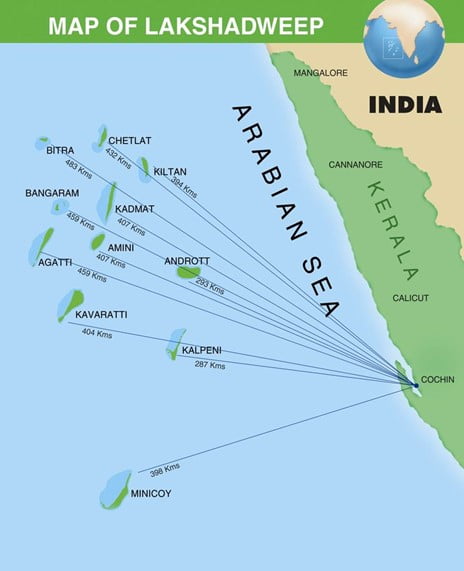
4. Puducherry (Pondicherry)
| Particulars | Description |
| Area | 479 sq km |
| Population | 12,44,464 (Approx) |
| Capital | Puducherry |
| Languages | Malayalam, Tamil, Telugu, English, and French |
- Previously called Puducherry, it was known as Pondicherry.
- The union territory of Puducherry has former French establishments of Yanam, Karaikal, and Mahe, all scattered in various places in South India.
- 4 small geographically unconnected parts constitute the union territory of Puducherry.
- Mahe district is enclosed by Kerala, Yanam district is enclosed by Andhra Pradesh, and Puducherry and Karaikal are enclosed by the state of Tamil Nadu.
- Puducherry is the third most densely populated union territory.
- The popular tourist attractions in Puducherry are churches, parks, beaches, temples, etc.
- The famous Indian Nationalist, poet, philosopher and yoga guru Sri Aurobindo was the resident of Puducherry
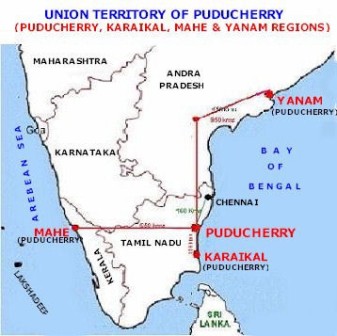
5. NCT of Delhi
| Particulars | Description |
| Area | 1,483 sq. km |
| Population | 1,67,53,235 (Approx) |
| Capital | Delhi |
| Languages | Punjabi, Hindi, Urdu, and English |
- Delhi is a city and a union territory of India.
- New Delhi is the capital of India.
- Delhi is on the banks of the Yamuna River, which is unfortunately very highly polluted. The actions taken to clean the Yamuna River are highly inadequate.
- It shares boundaries with the Indian states of Uttar Pradesh and Haryana.
- It has UNESCO World Heritage sites.
- In history, Delhi was the capital of the Mughal Empire, Delhi Sultanate, and British India.
- In wealth, Delhi ranks second in the number of billionaires in India
- In the past, Delhi had hosted important sporting events such as the Cricket World Cup, Hockey World Cup, Commonwealth Games, and Asian Games.

6. Chandigarh
| Particulars | Description |
| Area | 114 sq km |
| Population | 10,54,686 (Approx) |
| Capital | Chandigarh |
| Languages | Punjabi, Hindi, and English |
- Chandigarh is not only a union territory of India but also the joint capital of the states of Haryana and Punjab.
- Chandigarh is famously known as “Pensioners’ Paradise”.
- There are many famous schools and top higher educational institutions located in Chandigarh.
- It is famous for its urban design, architecture, green belts and tourist parks.
- Chandigarh is one of the earliest planned cities.
- It was designed by Le Corbusier, a Swiss-French architect.
- The capital complex in Chandigarh was declared a World Heritage Site by UNESCO in 2016.

7. Ladakh
| Particulars | Description |
| Area | 59,146 sq km |
| Population | 2.74 lakhs (Approx) |
| Capital | Leh |
| Languages | Ladakhi, Sino-Tibetan, Tibeto-Burman |
- Leh is the capital city of Ladakh.
- The largest town in Ladakh is Leh.
- The second largest town in Ladakh is Kargil.
- The famous Indus, Nubra, and Shyok river valleys are found in Ladakh.
- After the Government of India passed the Jammu and Kashmir Reorganisation Act in 2019, Ladakh was carved out as a separate union territory.
- Muslims are the majority in Ladakh, they constitute 46% of the population.
- Buddhists are 40% of the population, and Hindus are 12% of the population of Ladakh.
- Ladakh is bordered by the union territory of Jammu and Kashmir, the Indian state of Himachal Pradesh to the south, Tibet Autonomous Region to the east.

8. Jammu and Kashmir
| Union Territories | India |
| Capital | Jammu (winter), Srinagar (summer) |
| Area | 42,241 sq. km |
| Languages | Urdu, Balti, Kashmiri, Gojri, Dogri, Ladakhi, Pahari, and Dari |
- On 31 October 2019, Jammu & Kashmir was removed from its status as a state and converted into a union territory.
- Ladakh was separated from Jammu and Kashmir and was designated as a separate union territory.
- The literacy rate of the union territory is 67.16%.
- The most important languages of the union territory of Jammu and Kashmir are Hindi, English, Dogri, and Kashmiri.
- The economy of Jammu and Kashmir is mainly dependent on agriculture.
- Major agricultural exports from Jammu and Kashmir include apples, pears, cherries, plums, saffron and walnuts.
- Kishtwar in Jammu and Kashmir is known as the ‘land of sapphire and saffron’.
Constitutional Provisions for Union Territories of India
- The union territories are covered by Articles 239 to 241 in Part VIII of the Constitution, and their governmental structure is not standardised.
- The original Constitution’s Article 239 allowed the President to administer UTs directly through administrators.
- In 1962, Article 239A was introduced to give Parliament the power to establish legislatures for the UTs.
- To fulfil the aspirations of the people of these territories for democracy, several UTs were given a legislature and a Council of Ministers. By the Constitution (69th Amendment) Act of 1991, special provisions for the National Capital Territory of Delhi were introduced to Article 239AA of the Indian Constitution.
- Under Article 240, the President may enact laws to ensure the safety, development, and effective administration of the Andaman and Nicobar Islands, Lakshadweep, Dadra and Nagar Haveli, Daman and Diu, and Puducherry.
- In the instance of Puducherry, the President can only pass legislation after the assembly has been dissolved or suspended.
- The President’s regulations have the same legal weight as parliamentary acts.
- According to Article 241, the Parliament may declare any court in any territory to be a High Court for all or any of the purposes of the Constitution or establish by law a High Court for a Union Territory.
- Only Delhi’s NCT has a standalone High Court.
Need of Union Territory in India
The various justifications for the creation of UTs included the fact that these areas were either too tiny to be autonomous, too distinct (geographically, economically, and culturally) to be combined with neighbouring states, or were either weak economically or politically. Because of the aforementioned factors, they were unable to function as independent administrative entities and had to be governed by the Union Government.
- Given their location or unique status, several were designated as UTs. While Puducherry was governed by the French, the Portuguese ruled the UTs of Daman and Diu.
- They have a unique culture compared to the States around them, so additional measures may be needed to protect that identity while still allowing for efficient governance.
- Lakshadweep and Andaman and Nicobar are far from the Indian mainland and are strategically placed.
- From a national security perspective, it may be deemed necessary for the Union government to have control over them.
- Chandigarh serves as the administrative centre for Punjab and Haryana, whereas Delhi serves as the nation’s administrative centre.
- Delhi’s unique position in Indian politics as the nation’s capital makes the union government’s authority over it necessary.
We had 14 states and 6 UTs in 1956. The number of states rose throughout time to 28, and the number of UTs to 8. Since the 1960s, a number of UTs have expanded into full states, including Himachal Pradesh, Manipur, Tripura, Sikkim, Goa, Arunachal Pradesh, and Mizoram.
Difference between State and Union Territory of India
| State | Union Territory |
| It’s an independent body administered | It is not autonomous but rather managed by administrators appointed by the President. |
| There is an elected government in place for each administrative division within the state. | The Union Territories, which are constituent subdivisions, are under the supervision and administration of the Central Government. |
| The Executive Authority is the Governor. | The Executive Body is arguably the President. |
| There is a connection between the Centre and the federal government. | In a unitary state, all authority is vested in the leadership of the unions. |
| The Chief Minister is in charge | The President now appoints the Administrator |
Conclusion
The Union Territories of India represent a diverse range of cultures, languages, and histories, yet they are united under the central governance of the Indian Government. From the bustling streets of Delhi to the serene islands of Lakshadweep, each territory offers a unique slice of India’s vast heritage.

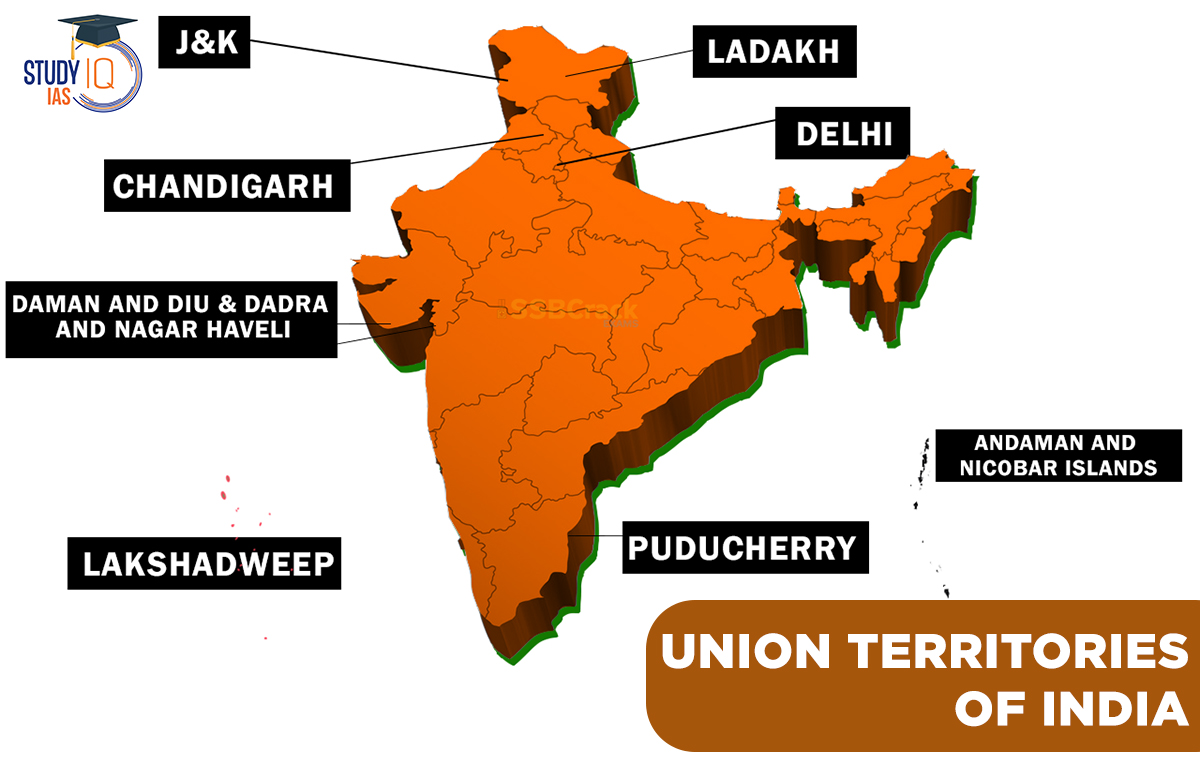
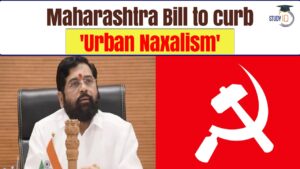 Maharashtra Bill to Curb Urban Naxalism,...
Maharashtra Bill to Curb Urban Naxalism,...
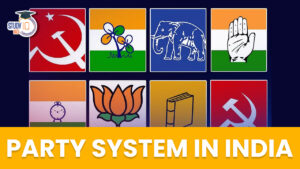 Party System in India, Feature, Importan...
Party System in India, Feature, Importan...
 Consolidated Fund of India, Meaning and ...
Consolidated Fund of India, Meaning and ...





















